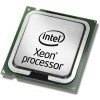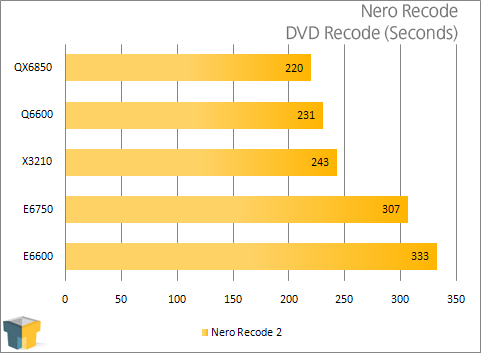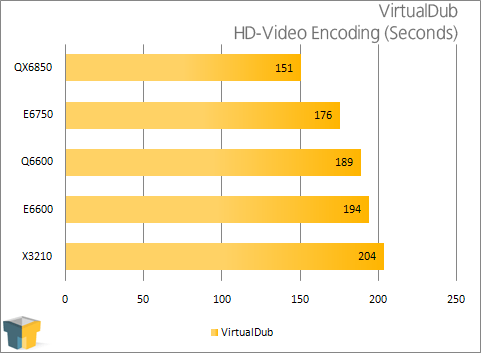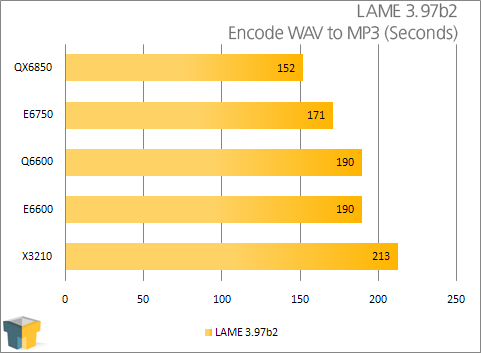- Qualcomm Launches Snapdragon 4 Gen 2 Mobile Platform
- AMD Launches Ryzen PRO 7000 Series Mobile & Desktop Platform
- Intel Launches Sleek Single-Slot Arc Pro A60 Workstation Graphics Card
- NVIDIA Announces Latest Ada Lovelace Additions: GeForce RTX 4060 Ti & RTX 4060
- Maxon Redshift With AMD Radeon GPU Rendering Support Now Available
Intel Xeon X3210 2.13GHz Quad-Core B3-Revision

One of the most popular CPUs on the market right now is the Q6600, thanks to the fact that it offers four cores at 2.4GHz. But what about the Xeon’s? Their prices are also more affordable now, with their X3210 2.13GHz retailing for $260. Read on as we pit this Quad-Core against the rest of our fleet.
Page 4 – Multi-Media Benches
Any type of multi-media encoding/re-encoding/conversion will greatly benefit from multi-core processors and those with faster frequencies. Nero Recode is a tool we enjoy using because it’s easy to use, and very effective. For testing, we first ripped our copy of Lamb of God’s concert DVD, “Killadelphia” and re-encoded it using Recode to fit on a normal sized 4.5GB DVD. The original DVD rip weighs in at 7.7GB.

For whatever reason, Nero Recode doesn’t utilize all cores 100%, but rather it hovers around 75%. I believe this to be so that the user will not have a laggy computer while the operation is in progress. Moving up from a dual-core to quad-core exhibits obvious benefits. Between our Quad-Cores, differences are there, but not as large as when compared to a Dual-Core.
If you chose “High-quality mode” for the recode process, it normally will use more than 75% of the overall CPU, but many will normally run the same settings that we had. However, because of the faster processors being released, many may move on over to the high-quality mode, simply because it’s faster than ‘normal’ mode was just a year ago, on any available CPU.
DVD ripping/re-encoding is a popular pass time, but so is video editing and conversion in general. For this test, we used VirtualDub 1.6.19 and DiVX 6.0. Using FRAPS, we originally recorded a three minute gameplay run of Half-Life 2, through the d1_canals_07 level recorded using a 1280×1024 resolution. The outputted file weighed in at 3.7GB, obviously far too large of a file to upload to share with friends. So, the file was re-encoded using the DiVX codec and also resized to a 640px wide resolution.

As you can see, the DiVX 6 encoder doesn’t take advantage of the quad-core to the fullest extent, but it usually hovered around 1.2 cores, on all five of our CPUs. For future reviews, we will be testing different video conversion tools to find a more appropriate multithreaded option.
Audio conversion is another popular scenario some people will run into, especially if they have FLAC files on their PC but want lossy versions for their iPod or other music player. Sadly, like VirtualDub, LAME is also a single-threaded application, so the results will scale with frequencies, not because of additional cores. There -is- a multithreaded version of the application available, but it’s constantly argued by audiophiles that the resulting quality is not as high as the singlethreaded version. So if you really care about the quality of your music, the single-threaded option is the smarter move.

As was expected, results scaled perfectly with frequency and not the amount of cores. That said, let’s move on to our workstation benchmarks, where Quad-Cores do make a big difference.
Support our efforts! With ad revenue at an all-time low for written websites, we're relying more than ever on reader support to help us continue putting so much effort into this type of content. You can support us by becoming a Patron, or by using our Amazon shopping affiliate links listed through our articles. Thanks for your support!





